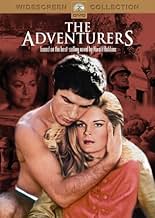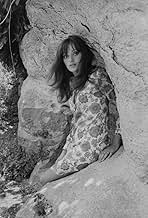This notorious howler can be called many things: long, tasteless, idiotic, even dull to some folks, but it can never be called cheap. This is an expensive and often, visually, quite impressive saga with many glorious scenic views and jaw-dropping interior locations. The story concerns Fehmiu who, as a boy, witnessed the savage slaughter of his mother and sister at the hands of soldiers in his native country of Corteguay. His father (Rey), a revolutionary, assists new leader Badel in rising to power and taking over the nation, but pays the price when his family is slain. Cut to a dozen or so years later and Fehmiu is an idle, polo-playing ladies man in Rome who has practically forgotten about the events in Corteguay. However, when new events draw his attention, he sets out to earn enough money to exact revenge and begin yet a new regime in the endlessly war-torn country. What better way to earn dough than to rent himself out as a gigolo to rich American wives such as de Havilland?! That's actually only step one in his plan. He uses the money to help build a fashion house (!) with his dethroned, Russian-royal schoolmate Berggren. When even that takes too long, he sets his sites on pretty American heiress Bergen, but once again he falls off the track of his ultimate goal until he finds that he has more to fight for than just his homeland. His childhood sweetheart Taylor-Young displays to him what he needs in order to reignite his fighting spirit and rebuild Corteguay. This is a sprawling story from an even more sprawling book (a hunk of Fehmiu's life is skipped over and two of his marriages aren't even shown!), but it could have been whittled down just a little if the opening scenes had been streamlined and some of the battle sequences shortened a bit. As it stands, viewers tuning in for the actions scenes are bored by the soap opera histrionics while lovers of camp and over-the-top melodrama are bored by all the explosions and gunplay. However, for those willing to wait out the bad for the good (no matter which is which), there are a few things here worth seeing. The cinematography of the film is magnificent. The scenery, the production design, the lighting, the decor and the costumes are all eye-catching. The battle scenes are well-done and the amount of extras used is staggering to behold. Long before CGI came along, someone had to wrangle the thousands of people present in the various scenes shown here and it pays off magnificently. As for the acting... Fehmiu is legendarily bad. He has a few effective moments, but is nowhere near multidimensional enough to carry a role like this in a film like this! Considered by many to be an attractive and virile (if wooden) leading man, he is something of a hatchet face with a lean, well-defined body. The character is never completely likable, but is made even less so by having such an uncharismatic person in the lead. He has two love scenes that are riotous. One by a pool surrounded by statues and another in a steamy, exotic greenhouse. Bergen is very uneven. Her early scenes are a bit awkward, her middle scenes better, but her later ones are hysterically awful as she inexplicably affects a bizarre accent and wanders around as if lobotomized. She is undeniably lovely, however, most of the time. Borgnine, who plays Fehmiu's personal bodyguard and friend, is ludicrous in sound and appearance at first, but, fortunately, improves greatly as the film wears on. De Havilland does what is probably the closest thing she ever had to a nude scene with only a sheet thrown over one shoulder as she romances Fehmiu. She manages to get through the movie relatively unscathed, as does Brazzi in a smallish role as one of Rey's Roman contacts (though in one scene Brazzi has the dubious honor of having to traipse through a house full of strategically naked young people!) Taylor-Young is handed a fairly colorless role, but is able to bring a little heart and appeal to it. One hilarious camp highlight is Fehmiu associate Aznavour's secret den of iniquity which truly must be seen to be believed. Another sequence not to be missed by any fan of 60's culture is the preposterous, ludicrous and thoroughly irresistible fashion show (complete with it's "plethora" of seven outfits!) As the planet's funkiest song radiates across a flashing dance floor, the models thrash around in a wide array of styles which seem unlikely to be of a particular collection. Cinema fashion shows are always a riot because the style is antiquated sometimes as early as the film's release date and this one is high in the pantheon of rancidness and wondrousness. Reporting on the clothes is "Teen Magazine reporter" Smith in one of her very earliest roles. It's long, it's tacky, it's wacky and it's empty-headed, but it's also stylish, attractive, intriguing and quite a treat for fans of all-star casts and hopeless kitsch.









































